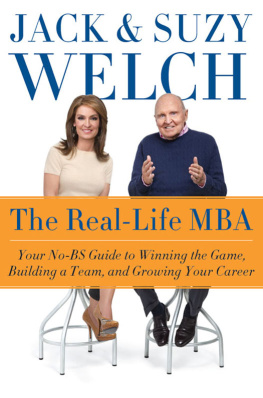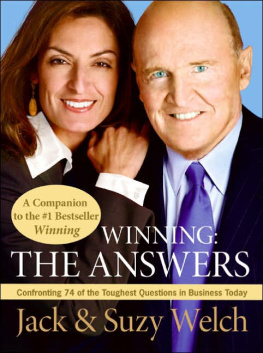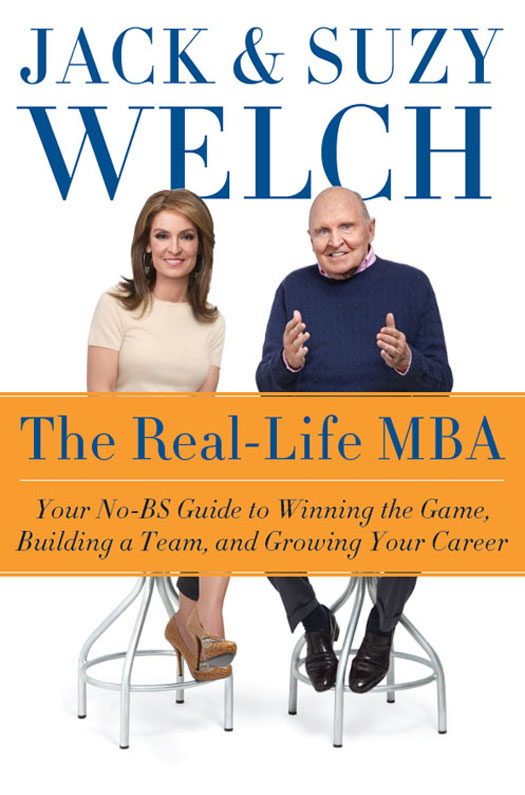CONTENTS
Guide
The video content at this location is not currently supported by your reader app or device. To view the video, please visit video.hc.com/1.
Business is best done together.
H ello and congratulationscongratulations on getting it.
No, not on getting this book, although were very happy you did.
Rather, congratulations on getting the fact that no one should do business alone.
Business is the ultimate team sport. Doesnt make any difference what size your company is, five people, or 5,000, or 150,000, for that matter. Doesnt matter if its in Gary, Indiana, churning out steel, or in Palo Alto cooking up code. Doesnt matter if youre three days into your first job in a windowless cube about 10,000 light-years from the action, or if you run the whole enchilada from a corner office on the forty-fifth floor of headquarters.
Business is not a me thing. Its a we thing.
Its an Ill take all the advice and ideas and help I can get thing.
Which is where our congratulations come in. If youre reading The Real-Life MBA, we figure youre with us on this one. When it comes to business, you can never stop learning. Business is just too vast, too multifaceted, too unpredictable, too tech-driven, too human-driven, too global, too local, too everything to ever be able to say, Been there, done that. For goodness sake, were still learning, and between us, weve been in business for a combined 81 years, with the last ten being the most mind-expanding of all.
Yes, the last ten have been the most full of learning for us, and heres why. After our last book, Winning, was published in 2005, we hit the road, launching a decade of speaking, writing, teaching, and consulting that has brought us inside scores of companies, each one facing fascinating marketplace and management challenges. Weve worked with an entrepreneur in China building a firm to link foreign companies and local manufacturers, a winery in Chile transitioning away from family-owned leadership, and a young aerospace venture in Phoenix in the midst of figuring out when and how to go public. These experiences, and many more, have been windows into the nitty-gritty trials and opportunities of business in todays world. At the same time, our speaking engagements to upwards of a million people, mainly in Q&A sessions, continually allow us to hear what businessmen and women are really thinkingand worryingabout. Add to that the work that one of us (Jack) has been doing in private equity and advising CEOs since 2002, evaluating, guiding, and growing dozens of companies, in industries ranging from health care to water treatment to online dating. Finally, it was in this period that we successfully launched our own online MBA, the Jack Welch Management Institute at Strayer University, now 900 students strong. Their richly varied experiences as working professionals around the world have broadened, deepened, and informed our understanding of business today in new and exciting ways.
If we knew something about business when we wrote Winning, the fact is, we know more now. More thats relevant. Because business has changed, and weve been lucky enough to be in the thick of it. Thats not to say what weve learned in the past decade has negated the principles and practices of Winning; quite the opposite. But what weve learned since 2005 has expanded, updated, and augmented them, in some cases just a bit, and in others, radically.
Indeed, these are radical times. Theyre exciting times. Sure, in some ways, its more challenging than ever to do business. Thats undeniable. The economy today isnt growing as it once did, to put it mildly; governments everywhere are more intrusive; global competition is fiercer every quarter; and technology just keeps propelling things forward faster and faster and faster.
At the same time, were in an era of dazzling innovation. Not just in terms of cool new products and engineering processes, which seem to improve every time you blink, but in terms of how companies and people get work done. Back in 1925, President Calvin Coolidge famously said, The chief business of the America people is business. Today, nearly a century later, wed jigger that quote to read, The chief business of the world is business. Practically everybody, practically everywhere, is making something, selling something, creating something, building something. This is the era of perpetual entrepreneurism, personal and professional, in organizations both small and massive, in economies old and brand-new.
Stand still at your peril. Or to be more precise, stop learning at your peril.
Better yet, embrace learning, and watch what happens to your organization, your team, and your career. Excitement. Growth. Success.
Our hope and intention is that The Real-Life MBA will be a part of that embrace. A big part, actually; a very current, highly useful, immediately applicable part.
You might want to use this book to supplement the MBA youre getting right now, either at a traditional campus or online. But this book is actually for anyone and everyone who is looking for a down-to-earth, no-BS primer on the big ideas and the best learn-it-today, apply-it-tomorrow techniques of an MBA. You may have already finished business school, for instance, but theres some dust on your diploma. Or you may be in a place in your life where suddenly knowing about business matters. Your first job out of college. Your first promotion to boss. Your first managerial role at a nonprofit. Your first day as CEOand employee No. 1of your own start-up. (Go for it!)
This book, in other words, is for anyone who doesnt want to do business alone.
Now, does The Real-Life MBA contain everything you need to know about business? Of course not. We urge you to learn about business from every possible source: colleagues, bosses, TV, websites, newspapers, conferences, podcasts, and, yes, other books. Find experts in your industry that you respect and follow them. Find experts in your industry you disagree with and pay attention to them, too.
Our goal here is not to make you into a functional specialist of any sort. Our goal is to codify the business of business today, to give you a framework for understanding what business is about now, and how the game is played, no matter what industry youre in or hope to enter someday.
To that end, The Real-Life MBA opens with a section called Its About the Game. Its chapters explore the ways in which companies, no matter what their size or type, should organize and operate to win in the marketplace: how they can get everyone aligned around a mission and behaviors, for instance, create strategy that never gets stale, rebound from a competitive drubbing, galvanize growth even in a slow-growth environment, and impel innovationnot just among the big brains in R&D, but among everyone. The first section of this book also takes a look at how to think about marketing and finance, two subjects that generate a lot of sound and fury and a big dose of anxiety, but definitely need not. And finally, the Its About the Game section of The Real-Life MBA talks about how to deal with one of the realest parts of real business today: a crisis. After all, almost no one can avoid the #RomanColiseum of public opinion anymore.
The second part of this book is called Its About the Team. It contains our new model for leadership; its just two imperatives, each one incredibly hard to implement yet incredibly necessary. Weve also found this model to be incredibly transformative at the companies that have adopted it. Also in this section of














